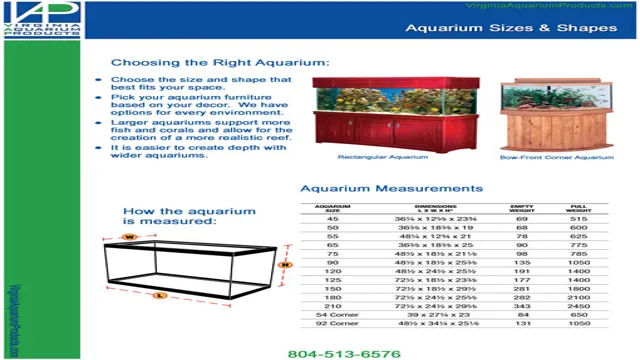Are you a newbie in the world of aquariums and struggling to determine the size of your tank? Don’t worry; you’re not alone. Calculating aquarium gallons can be confusing, especially if you don’t have a mathematical background. But fret not, as we’re here to help you figure it out.
Knowing the size of your aquarium is crucial to maintaining a healthy environment for your aquatic pets. A tank that’s too small can lead to poor water quality, while a too-big tank might not be suitable for the type of fish you have. So, how do you calculate your aquarium gallons? In this step-by-step guide, we’ll walk you through the process of measuring your tank’s dimensions and converting them into gallons.
We’ll also provide you with a few tips on how to select the right aquarium size for your fish. By the end of this article, you’ll be able to determine the exact capacity of your aquarium and create a comfortable habitat for your underwater friends. So, grab a pen and paper, and let’s get started!
Why Knowing Your Aquarium’s Gallons Matters
As a fish enthusiast, knowing the size of your aquarium is essential to maintaining a healthy environment for your aquatic pets. Calculating the number of gallons your aquarium holds can be a bit confusing, but it’s necessary to understand. The easiest way to figure out your aquarium’s gallons is by using a specialized tool called an aquarium volume calculator.
You’ll need to enter the dimensions of your aquarium, which includes the length, width, and height measurements. Knowing your tank’s size is crucial when it comes to achieving the correct filtration capacity and stocking levels for your aquarium. Without the proper filtration, your fish will be in danger of living in unsafe water conditions, leading to health problems, and ultimately, death.
Knowing how to figure out your aquarium’s gallons will help you make informed decisions for your tank’s health and keep your fish happy and thriving.
Benefits of Knowing Your Aquarium’s Gallons
Knowing the volume or gallons of your aquarium is crucial for a number of reasons. First and foremost, it helps you determine the appropriate filtration system and size of the tank for your specific fish species. Overcrowding can lead to poor water quality, diseases, and stress, which can ultimately be detrimental to your fish’s health.
By knowing the gallons of your aquarium, you can also calculate the amount of water you need to change regularly to maintain optimal water parameters. This is important since changing too little or too much water can also lead to problems for your fish. Overall, taking the time to measure and understand the size of your aquarium can greatly benefit your aquatic pets and their overall well-being.

Potential Problems if You Don’t Know Your Aquarium’s Gallons
Knowing the gallon capacity of your aquarium is crucial in maintaining the health of your aquatic pets. Without knowing the proper amount of water that can fit in your tank, you could run into several problems that could potentially harm the fish and other organisms living inside. Overcrowding is a prevalent issue that arises from not knowing the correct number of gallons your aquarium can hold.
A crowded environment can lead to poor water quality, as there might not be enough space for the natural filtration system to function properly. This, in turn, could create ammonia spikes and other harmful toxins, which could cause your fish to become sick or even die. Thus, it is crucial to know your aquarium’s gallon capacity to avoid these potentially hazardous situations and provide a healthy environment for your aquatic pets.
Calculating Your Aquarium’s Gallons
If you’re a beginner in the world of aquariums, figuring out how to calculate your aquarium’s gallons can be a little overwhelming. But don’t worry, it’s actually quite simple. First, you’ll need to measure your tank’s length, width, and height in inches.
Multiply those three numbers together to get the total cubic inches of your tank. Then, divide that number by 231 (the number of cubic inches in one gallon) to find out how many gallons your aquarium can hold. For example, if your tank measures 24 inches in length, 12 inches in width, and 16 inches in height, the total cubic inches would be 4,60 (See Also: How to Prep Water for Planted Aquarium: Tips and Tricks for Optimal Plant Growth)
When divided by 231, that means your aquarium can hold approximately 20 gallons. It’s important to know the exact number of gallons your aquarium can hold so that you can properly maintain it and ensure the health of your aquatic pets.
Measure the Length, Width, and Height of Your Aquarium
Measuring the length, width, and height of your aquarium is an essential step in calculating its gallons. Aquariums come in different sizes and shapes, and knowing the measurements is crucial in determining the amount of water it can hold. To calculate your aquarium’s gallons, you first need to measure the length, width, and height of the tank in inches.
Next, multiply the length, width, and height together to get the cubic inches. Finally, divide the cubic inches by 231 (the number of cubic inches in one gallon) to get the number of gallons your aquarium can hold. For example, if your aquarium measures 12 inches long, 6 inches wide, and 8 inches tall, multiplying those numbers gives you 576 cubic inches.
Dividing 576 by 231 gives you around 49 gallons of water that your aquarium can hold. Knowing your aquarium’s capacity is crucial in ensuring the well-being of your fish and other aquatic creatures.
Calculate the Volume of Your Aquarium in Inches
Calculating the volume of your aquarium is an important process that aquarists must undertake before adding any fish or plants to the tank. It helps to ensure the tank is not over or understocked, which can cause health problems for the inhabitants. To calculate the aquarium’s volume, you need to measure the length, width, and height of the tank in inches.
You can use a measuring tape or ruler to measure each dimension and then multiply the values together. Once you have the result, you can use a conversion formula to obtain the aquarium’s volume in gallons. The formula to calculate the aquarium’s capacity is: Length x width x height ÷ 231 = gallons.
For example, if your tank measures 24 inches in length, 12 inches in width, and 16 inches in height, the calculation would be: 24 x 12 x 16 ÷ 231 = 163 gallons. It is essential to note that you need to consider the tank’s shape when calculating the volume, as it can affect the result.
For instance, cylindrical tanks require a different formula to calculate their volume. By calculating your tank’s volume accurately, you can create a suitable environment for your aquatic pets.
Convert Inches to Gallons
If you’re an aquarium enthusiast, you may find yourself needing to know the volume of water your tank can hold. Calculating your aquarium’s gallons is easy if you know the measurements of your tank in inches. First, measure the length, width, and height of your aquarium in inches.
Then, multiply the length by the width and height, and divide the result by 23 This will give you the number of gallons your aquarium can hold. Keep in mind that this calculation assumes your tank is rectangular.
If your tank has a different shape, you’ll need to use a different formula to determine its volume. By knowing the number of gallons your aquarium can hold, you can ensure you’re providing the appropriate amount of water for your fish to thrive. (See Also: How to Make Snake Aquarium Cover at Home: Step-by-Step DIY Guide)
General Tips for Maintaining Your Aquarium
One of the key factors in maintaining an aquarium is understanding the appropriate size of the tank. Knowing how to figure aquarium gallons is essential to ensure you’re providing the right environment for your fish and aquatic plants. To determine the size of your aquarium, measure the length, width, and height in inches.
Then, multiply these measurements and divide that number by 231 to get the total gallons. It’s important to consider the number and type of fish you plan to keep before choosing the size of your tank. Overcrowding can lead to stressed and unhealthy fish, so make sure to choose a tank size that will accommodate them comfortably.
Additionally, regularly testing the water quality and performing routine maintenance tasks such as water changes and filter cleaning can help keep your aquarium healthy and vibrant.
Understanding Your Aquarium’s Needs
Maintaining your aquarium can seem like a daunting task, but it doesn’t have to be! There are several general tips you can follow to keep your aquarium healthy and thriving. Firstly, make sure to regularly clean your tank and filters to remove any buildup of waste or debris. Secondly, keep an eye on the water quality and pH levels in your tank to ensure they remain within a healthy range for your aquatic inhabitants.
Thirdly, choose appropriate lighting for your aquarium and keep it on for only 8-10 hours per day to mimic natural light cycles. Fourthly, feed your fish and other aquatic creatures a balanced and appropriate diet, being mindful not to overfeed. Lastly, consider the specific needs of the creatures in your aquarium, such as temperature and water flow, and make any necessary adjustments to ensure their health and well-being.
By following these general tips, you can create a thriving and beautiful aquatic environment for your beloved pets.
Common Maintenance Practices for all Aquariums
As an aquarium enthusiast, you know that keeping your aquarium clean and healthy is crucial for the wellbeing of your aquatic pets. Regular maintenance practices will help keep your aquarium in tip-top shape. One important thing to keep in mind is to perform regular water changes.
It’s recommended to do a 10-15% water change every week to remove accumulated waste and other debris. Additionally, make sure to clean your aquarium filters regularly. This helps to prevent the buildup of harmful bacteria and other harmful substances.
Finally, keep an eye on your aquarium’s overall condition. Be on the lookout for signs of algae growth, sick fish, or other problems that may indicate that there’s an issue with your aquarium’s cleanliness. By following these basic maintenance practices, you can ensure that your aquarium is a healthy and thriving habitat for your aquatic pets.
Conclusion: Knowledge is Power
In conclusion, calculating the gallon size of your aquarium is a simple yet important task for any fish owner. Just measure the length, width, and height of the tank in inches, multiply them together, and divide by 231 (the number of cubic inches in a gallon). Whether you’re a seasoned aquarist or a novice fish enthusiast, understanding the size of your aquarium will ensure a healthy and happy home for your scaly friends. (See Also: How to Clean an Aquarium Filter Sock and Keep Your Fish Tank Crystal Clear)
So go forth, armed with this knowledge, and let the tanks be filled!”
FAQs
How do I calculate the volume of my aquarium in gallons?
To figure out the gallons in your aquarium, measure the length, width, and height of your tank in inches. Then, multiply those three numbers together and divide by 231 to get the total number of gallons.
Does the shape of my aquarium affect the gallon calculation?
Yes, the shape of your aquarium can affect the gallon calculation. If your tank is not a regular rectangular shape, you will need to use a different formula to calculate the volume in gallons.
What if my aquarium has a curved front or bowfront?
If your aquarium has a curved front or bowfront, you will still need to measure the length, width, and height of the tank, but you will also need to use a displacement method to calculate the volume in gallons.
Can I estimate the gallon volume of my aquarium without measuring?
While it is possible to estimate the gallon volume based on the manufacturer’s specifications or by using an online calculator, the most accurate way to determine the gallon volume is by measuring the length, width, and height of the tank.
How often should I measure the water volume in my aquarium?
It’s a good idea to check the volume measurement of your aquarium whenever you do a water change or add or remove decorations or substrate.
How does the water level affect the gallon calculation?
The water level in your aquarium can affect the accuracy of your gallon calculation. Be sure to measure the total length, width, and height of the tank including the water level.
Can I use the gallon calculation to determine how many fish I can add to my aquarium?
While the gallon calculation can give you an idea of the volume of your tank, it is not the only factor to consider when adding fish. You should also consider the type and size of fish, filtration, and proper stocking levels.







